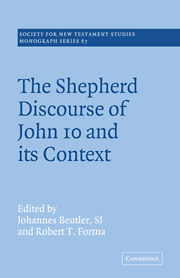Book contents
- Frontmatter
- Contents
- List of abbreviations
- Introduction
- 1 Open questions on John 10
- 2 Der alttestamentlich-jüdische Hintergrund der Hirtenrede in Johannes 10
- 3 The history of religions background of John 10
- 4 Tradition, history and interpretation in John 10
- 5 John 10 and its relationship to the Synoptic Gospels
- 6 A syntactical and narratological reading of John 10 in coherence with chapter 9
- 7 Johannes 10 im Kontext des vierten Evangeliums
- Notes
- Index
3 - The history of religions background of John 10
Published online by Cambridge University Press: 10 October 2009
- Frontmatter
- Contents
- List of abbreviations
- Introduction
- 1 Open questions on John 10
- 2 Der alttestamentlich-jüdische Hintergrund der Hirtenrede in Johannes 10
- 3 The history of religions background of John 10
- 4 Tradition, history and interpretation in John 10
- 5 John 10 and its relationship to the Synoptic Gospels
- 6 A syntactical and narratological reading of John 10 in coherence with chapter 9
- 7 Johannes 10 im Kontext des vierten Evangeliums
- Notes
- Index
Summary
In this study of the Johannine discourse on the Good Shepherd, I propose to take the text of John 10 section by section, and inquire into the possible religious and conceptual backgrounds for the major images and concepts employed by the evangelist. It is true that I implicitly endorse the observation that some dislocation has occurred in the text, as reflected in the order of treatment I adopt, 10:19–30; 10:1–18; and 10:31–42. But I am not wholly convinced that this is the original order, and in any case offer no explanation for how the text came to be in its present state. Nevertheless, the order of treatment I adopt will not materially affect my treatment of the question I am trying to deal with: the background and environment of the Johannine shepherd discourse, with particular attention to the Graeco-Roman conceptual sphere and the question of possible relationships to Gnosticism.
In the course of my treatment I shall occasionally stray beyond these confines, particularly into ancient Near Eastern and OT territory, since these spheres did not exist in isolation from the more Hellenic sphere, and in any case, because I see there an important basis on which to understand the shepherd imagery of the discourse. In addition to the shepherd I shall attend particularly to the motif of the sheep's recognition of the shepherd by means of being ‘his own’ and by recognising his ‘voice’.
I shall explore also certain possibilities for a Gnostic understanding of the text. Various features of the discourse certainly lend themselves to a Gnostic understanding, but whether it was intended as such I am reluctant to believe.
- Type
- Chapter
- Information
- The Shepherd Discourse of John 10 and its Context , pp. 33 - 52Publisher: Cambridge University PressPrint publication year: 1991
- 2
- Cited by



